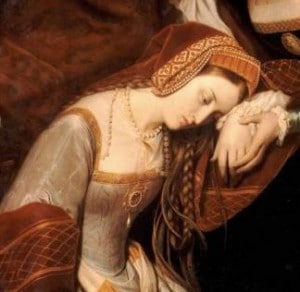 On the same day that her predecessor, Catherine of Aragon, was laid to rest, Anne Boleyn miscarried. The Imperial ambassador reported the miscarriage to his master, Charles V:-
On the same day that her predecessor, Catherine of Aragon, was laid to rest, Anne Boleyn miscarried. The Imperial ambassador reported the miscarriage to his master, Charles V:-
“On the day of the interment [Catherine of Aragon’s funeral] the Concubine had an abortion which seemed to be a male child which she had not borne 3½ months, at which the King has shown great distress. The said concubine wished to lay the blame on the duke of Norfolk, whom she hates, saying he frightened her by bringing the news of the fall the King had six days before. But it is well known that is not the cause, for it was told her in a way that she should not be alarmed or attach much importance to it. Some think it was owing to her own incapacity to bear children, others to a fear that the King would treat her like the late Queen, especially considering the treatment shown to a lady of the Court, named Mistress Semel, to whom, as many say, he has lately made great presents.”1
On the 25th February, Chapuys mentioned the miscarriage again:-
“I learn from several persons of this Court that for more than three months this King has not spoken ten times to the Concubine, and that when she miscarried he scarcely said anything to her, except that he saw clearly that God did not wish to give him male children; and in leaving her he told her, as if for spite, that he would speak to her after she was “releuize.” The said Concubine attributed the misfortune to two causes: first, the King’s fall; and, secondly, that the love she bore him was far greater than that of the late Queen, so that her heart broke when she saw that he loved others. At which remark the King was much grieved, and has shown his feeling by the fact that during these festive days he is here, and has left the other at Greenwich, when formerly he could not leave her for an hour.”2
It is clear from Chapuys’ reports that both Anne and Henry were devastated by the loss of their son adn with hindsight we can see that this miscarriage made a huge impact on Anne’s future, that she had “miscarried of her saviour”3. However, Chapuys is prone to exaggeration and Eric Ives points out that his reference to Henry VIII pretty much ignoring Anne for three months just is not true for “Chapuys had forgotten his own report of the king’s behaviour after Katherine’s death”4. Also Chapuys reads far too much into the King leaving Anne at Greenwich to celebrate Shrovetide at Whitehall – Anne had just had a miscarriage, surely she needed to recover!
Catholic recusant, Nicholas Sander, who was in exile during Elizabeth I’s reign, wrote of how Anne Boleyn had blamed her miscarriage on catching the King with Jane Seymour on his lap, and Jane Dormer (Duchess of Feria and lady-in-waiting to Mary I) also wrote of this and reported that “there was often much scratching and bye-blows between the queen and her maid.”5 Eric Ives calls such reports “late embroidery”6 because there is plenty of evidence of Henry making “determined efforts to persuade Europe to accept Anne as his legitimate wife” and concludes:-
“The miscarriage of 29 January was neither Anne’s last chance nor the point at which Jane Seymour replaced Anne in Henry’s priorities. It did nevertheless make her vulnerable yet again.”7
But what about the deformed foetus story?
The Deformed Foetus
“The Other Boleyn Girl” book has Anne miscarrying a “monster”:-
“In the midwife’s bloody hands was a baby hardly malformed, with a spine flayed open and a huge head, twice as large as the spindly little body.”8
This idea comes from Nicholas Sander’s report that Anne miscarried “a shapeless mass of flesh”9, but Nicholas Sander was only around 6 years of age in 1536 and he was purposely trying to blacken Anne Boleyn’s name when he was in exile during her daughter’s reign. His report of this deformed foetus is not backed up by any other source and don’t you think that Chapuys would have gleefully reported it to Charles V if this had happened? Both Chapuys and the chronicler Charles Wriothesley simply state that she miscarried a male child of around 15 weeks in gestation.
Was Anne Boleyn’s miscarriage responsible for her fall?
You can read my article on this at “Was Anne Boleyn’s Miscarriage Responsible for her Fall?” but I agree with Eric Ives – it made her vulnerable but it did not cause her downfall. A successful pregnancy resulting in a boy would obviously have saved Anne Boleyn but we cannot pin her downfall and execution on the events of the 29th January 1536.
Notes and Sources
- LP x.284
- Ibid., 351
- “Queen Elizabeth”, J. E. Neale
- The Life and Death of Anne Boleyn, Eric Ives, p299
- Ibid., p300
- Ibid.
- Ibid.
- “The Other Boleyn Girl”, Philippa Gregory, p277
- “The Rise and Growth of the Anglican Schism”, Nicholas Sander